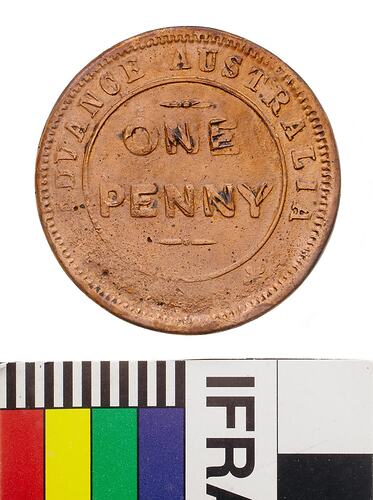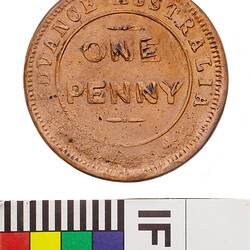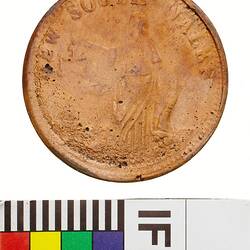Summary
Australia New South Wales Sydney
Whitty & Brown Token Penny c.1860 (AD)
Mint: Whitty and Brown
Previous Collections: Hon. William M.K. Vale
Standard References: Andrews 632 = Heyde 5/1
Physical Description
A round copper token (34 mm diameter). The token does not include the name the issuer and manufacturer: Whitty & Brown, Sydney, but the shared reverse die and characteristic poor workmanship make it clear that this company was responsible. It features the denomination and the motto Advance Australia on the obverse and a representation of Justice standing blindfolded holding scales and an inverted cornucopiae spilling fruit on the ground. A sailing ship is on the horizon. The die work is of poor quality and the token weakly struck, cleaned and varnished. This token shows effects of double striking around the lettering.
Obverse Description
At centre within line circle, ONE / PENNY; around, ADVANCE AUSTRALIA +++
Reverse Description
Justice blindfolded standing facing to left on beach; extends balanced scales in rirgh hand and holds inverted cornucopia in left from which fruits flow onto the ground passed her feet and onto the left side of the token; three-masted sailing ship in background at left.
Edge Description
Plain
More Information
-
Collecting Areas
-
Acquisition Information
Transfer from National Gallery of Victoria (NGV), Honourable William M. Vale JP, 15 Mar 1976
-
Date Issued
circa 1860 AD
-
Issued By
Whitty & Brown (Mint), Sydney, Greater Sydney, New South Wales, Australia
-
Mint
Whitty & Brown (Mint), Sydney, Greater Sydney, New South Wales, Australia, 1850-1868
-
Previous Collection
-
Inscriptions
Obverse: ONE PENNY ADVANCE AUSTRALIA Reverse: NEW SOUTH WALES
-
Denomination
-
Series
-
Material
Copper
-
Axis
11
-
Classification
-
Category
-
Discipline
-
Type of item
-
Dimensions
33 mm (Outside Diameter), 16.628 g (Weight)
-
Shape
Round
-
References
Andrews 632 = Heyde 5/1 The museum storage system is based on the die combination not on the movement of the dies during production. This series of tokens is believed to have been struck employing a drop hammer. This has resulted in most examples exhibiting double striking. On some occasions the token or die moved to such an extent between strikes as the die bounced that some early collectors described different types - particularly refering to the number of beads in the upper and lower bars of the obverse. Andrews, p.101, correctly pointed out that a tiny flaw from the C of ADVANCE to the inner circle, is found on all tokens. He correctly argues "This would indicate that the variations are due to the mode of manufacture entirely." This was followed by Heyde p.26 and in the museum storage. Four reverse dies were employed with the "One Penny" obverse - two depicting Justice: Reverse 1: the re-engraved form of Justice with a square sleeve on her right arm and the fruit pouring from the inverted cornucopiae flowing along the ground to the left and right of the figure. Reverse 2: a new Justice with clearer defined head and blindfold with the fruit pouring only on the right side of the figure. There seems to be no definition of a ground line on this die. It broke in numerous places during the striking of this issue and does not occur with any other obverse. and two depicting an emu and Kangaroo facing each other: Reverse 3: The emu and kangaroo close together, 0.6 mm from the kangaroo paw to the emu neck Reverse 4: The emu and kangaroo distant, 2.0 mm from the kangaroo paw to the emu neck
[Book] Andrews, Arthur. 1921. Australasian Tokens and Coins.
[Book] Heyde, Gilbert C. & Skinner, Dion H. 1967. Unofficial Coins of Colonial Australia and New Zealand.




